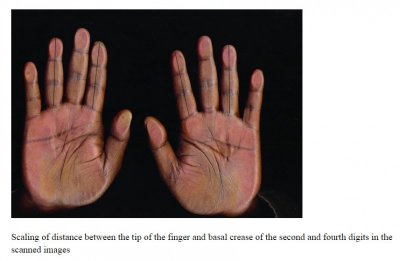Nelson Vergel
Founder, ExcelMale.com

J Clin Diagn Res. 2015 May;9(5)
Relationship Between Second to Fourth Digit Ratios and Benign Prostatic Hyperplasia in Aging Men.
Sudhakar HH1, Manjunatha R2, Madhusudhana HR3.
Abstract
INTRODUCTION:
Benign prostatic hyperplasia (BPH) is the most common prostate disease, characterized by benign enlargement of the prostate gland in aging men. Testosterone is said to be the major factor in development of BPH. The relative length of 2nd and 4th digit (2D:4D) is a marker for prenatal androgen exposure. A low 2D:4D ratio is associated with a high prenatal androgen exposure. The main objective of this study was to assess the causal relationship between the 2D:4D ratio and incidence of BPH.
MATERIALS AND METHODS:
Thirty five patients with BPH were compared with 35 non BPH subjects and 35 controls recruited from general population for measures of 2D:4D ratio. BPH status was determined by clinical & radiological evaluation. Both hands of all the participants were scanned and their second and fourth digit lengths were measured and the ratio calculated.
RESULTS:
In the present study, 2D:4D ratio was lower in BPH patients compared to non BPH subjects in both hands. Compared with controls, BPH patients had lower 2D:4D ratio in the right hand, but the difference between the groups in left hand 2D:4D ratios was not significant. Compared with controls, non BPH subjects had higher 2D:4D ratio in the left hand, but the difference between the groups in right hand 2D:4D ratios was not significant.
CONCLUSION:
Results of the present study indicate that individuals with lower 2D:4D ratios are at a higher risk of developing BPH and those with higher 2D:4D ratios are at a lower risk of developing BPH compared to the general population.
















